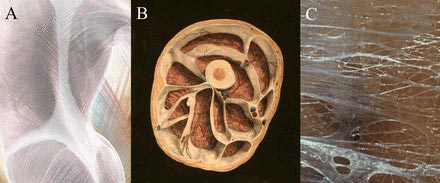Mark Kelly, registered Myotherapist at Jasper Health
A Fascia is a band or sheet of connective tissue beneath the skin that attaches, stabilizes, encloses, and separates muscles and other internal organs. The fascial system is comprised of different types of connective tissue, which are made up of different types of fibres. These include Collagen, which provides tensile strength, Elastic Fibres which gives fascia the ability to recoil, and Reticular Fibres, fine fibres which crosslink to form a meshwork.
Fascia is made up of a mix of loose and dense fibrous connective tissue that allow the body’s different systems to operate in an integrated unit, or one large networking organ. For example, fascial tissue that is dense and strong is primarily what our tendons are made of. This connective tissue allows the forces generated by muscle contractions to act on a bone to produce joint movement. The body’s fascia is designed to aid with force transmission. For example, when we move the fascial system together with our muscles, they perform an important balancing act where they act as elastic bands, and our bones and joint structures form struts or a framework to resist compression forces on the body. Along with other functions such as the nervous system, this system is important as it contributes to our movement to being smooth and coordinated.

(Ref M. Zugel, 2018)
Restriction and repair:
Fascial restriction can be caused by many different factors, strain and tightness can build up and affect multiple groups of muscles and associated fascia. Fascial connections can affect multiple regions of the body, causing the development of more widespread tightness and even pain. As a result of fascial imbalances, range of motion can decrease and movement becomes stiff. The body becomes less efficient and more prone to injury. Below are some examples.
- Injury: if a muscle is injured fibrous scar tissue is laid down in the healing process. Muscle tightness is in part associated with fascial shortening which can occur due to the way our body remodels after injury.
- Immobilization: It has been shown that in early phases of immobilization from injury, illness or lack of activity, increased muscle tightness is due to the shortening of fascia. In more chronic cases, it is most often the case where there is a fear factor of the original issue returning or re-injury which leads to the patient not exercising or not wanting to stress the injured area and movement imbalanced can develop.
- Habitual postures: Fascia can become shortened due certain muscular holding patterns associated with faulty posture. Often people can have imbalances for many years and experience no associated pain however, over time these imbalanced can start to contribute to the development of pain or injury.
How can Myotherapy at Jasper Health help?
Myotherapists are trained in the assessment, treatment and management of dysfunction associated with the myofascial (Muscles and Fascial) system. The aim from a Myotherapy perspective would be provide the patient with advice on how to improve fascial restriction and restore movement. Soft tissue therapy such as Myofascial Release Techniques are used to improve imbalances and home exercise programs can be prescribed to help restore the body. Myotherapists will work together other health professionals to best manage patients.
Research and evidence:
- Ranger, A Teichtahl (2016), Investigated the relationship between the thoracolumbar fascia and lower back pain and disability. They found that shortened fascia around the lumbar spinal region was associated with higher intensity lower back pain.
- Sanchaz (2011), Looked at the benefits of Myofascial Release Therapy on pain, anxiety, quality of sleep, depression, and quality of life in patients with Fibromyalgia Syndrome. Areas focussed on were release of the temporal area, cervical fascia, anterior thoracic wall, pectoral area, lumbro-sacral and gluteal fascia, quadriceps and forearm flexors. They found “significant reductions in sensitive points as measured by pressure algometer”.
- Myers 2006. Looked at the evidence of myofascial connections or lines throughout the body.
References
- Zügel, C, Maganaris (2018) Fascial tissue research in sports medicine: from molecules to tissue adaptation, injury and diagnostics: consensus statement. British Journal of Sports Medicine, Vol 52/23.
- Sanchaz, G. Pe˜narrocha (2011) Benefits of Massage-Myofascial Release Therapy on Pain,
Anxiety, Quality of Sleep, Depression, and Quality of Life in Patients with Fibromyalgia. Evidence-Based Complementary and Alternative Medicine Journal.
- Ranger, A Teichtahl (2016), Shorter Lumbar Paraspinal Fascia Is Associated
With High Intensity Low Back Pain and Disability. Wolters Kluwer Health, SPINE Volume 41, Number 8, pp E489–E493.
- Myers (2006). Anatomy Trains Early Dissected Evidence, 15-18 Dytrains
https://courses.lumenlearning.com/boundless-ap/chapter/connective-tissue/ Lumen, Boundless Anatomy and Physiology. Organisation At The Tissue Level.
Author: Mark Kelly
Registered Myotherapist and Exercise Professional at Jasper Health.





